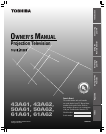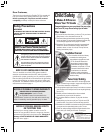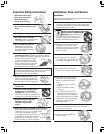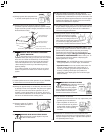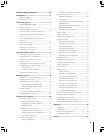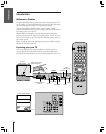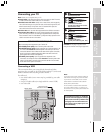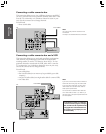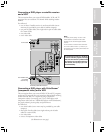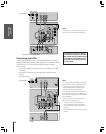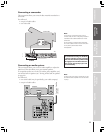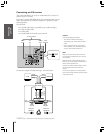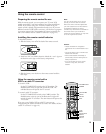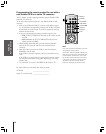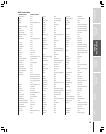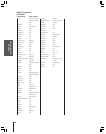
Introduction
Connecting
your TV
Using the
Remote Control
Setting up
your TV
Using the TV’s
Features
Appendix
Index
7
Connecting your TV
Note: Cables are not supplied with your TV.
Coaxial cable is the cable that comes in from your antenna, cable TV service,
or cable converter box. Coaxial cable uses “F” connectors.
Standard stereo A/V cables usually come in sets of three, and are typically
color-coded according to use: yellow for video, red for stereo right audio, and
white for stereo left (or mono) audio. Your TV’s standard A/V inputs are
color-coded in the same manner as the cables.
S-Video cable is for use with video equipment that has S-Video connectors.
Component video cables come in sets of three (typically color-coded red,
green, and blue), and are for use with video equipment that has component
video connectors. Your TV’s ColorStream
®
(component video) inputs are color-
coded in the same manner as the cables.
Note:
If you have a mono VCR, connect L/Mono to
VCR Audio OUT using only one audio cable.
If you have an S-VHS VCR, use an S-video
cable instead of a standard video cable for
better picture performance.
Do not connect a standard video cable and
an S-video cable to Video-1 (or Video-2) at
the same time or the picture performance will
be unacceptable.
CAUTION: Do not plug in any power cords
until you have finished connecting all equipment.
Coaxial (antenna) cable
Standard stereo A/V cables
(typically color-coded yellow for video,
red and white for audio)
S-video cable
Component video cables
(typically color-coded red, green, blue)
NOTE REGARDING PICTURE QUALITY
When connecting video equipment to your Toshiba TV:
For GOOD picture quality: Use a standard yellow video cable.
For BETTER picture quality: If your equipment has S-video connectors, use
an S-video cable instead of a standard yellow video cable. (You still must
connect the standard red and white audio cables for full system connection,
but do not connect a standard yellow video cable at the same time or the
picture performance will be unacceptable.)
For BEST picture quality: If your equipment has component video
connectors, use component video cables instead of a standard yellow video
cable or S-video cable. (You still must connect the standard red and white
audio cables for full system connection.)
Connecting a VCR
This connection allows you to watch local channels and video
programs, play or record on the VCR while watching TV, and record
from one channel while watching another channel.
You will need:
• two coaxial cables (one or more may be provided by your cable
company)
• one pair of audio cables (one single cable for a mono VCR)
• one video cable
ANT
(
75
)
ANT-1
CHANNEL IN
ON OFF
OUT
RL
OUT
VIDEO
VAR
AUDIO
L/
MONO
IN
DVD IN
L
R
P
R
P
B
Y
L/
MONO
AUDIO
R
S-VIDEO
VIDEO
OUT
ANT-2
AUDIO CENTER
VIDEO 1 VIDEO 2
COLOR
STREAM
INPUT
AUDIO
R
AUDIO
IN from ANT
VIDEO AUDIO
OUT to TV
CH 3
LR
CH 4
IN
OUT
Cable lead-in from
Cable Box or Antenna
Stereo VCR
TV
The unauthorized recording, use, distribution,
or revision of television programs, videotapes,
DVDs, and other materials is prohibited under
the Copyright Laws of the United States and
other countries, and may subject you to civil
and criminal liability.



